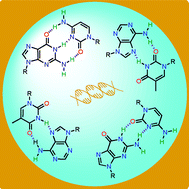Abstract
Hydrogen-bonding interactions in DNA/RNA systems are a defining feature of double helical systems. They also play a critical role in stabilizing other higher-order structures, such as hairpin loops, and thus in the broadest sense can be considered as key requisites to the successful translation and replication of genetic information. This importance, coupled with the aesthetic appeal of nucleic acid base (nucleobase) hydrogen-bond interactions, has inspired the use of such motifs to stabilize a range of synthetic structures. This, in turn, has led to the formation of a number of novel ensembles. This tutorial review will discuss these structures, both from a synthetic perspective and in terms of their potential application in areas that include, but are not limited to, self-assembled macrocyclic and high-order ensemble synthesis, supramolecular polymer preparation, molecular cage construction, and energy and electron transfer modeling.

